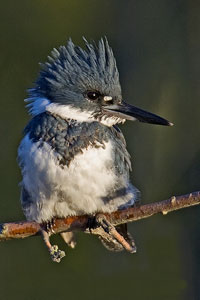

|
Belted Kingfisher (Ceryl alcyon) Rey Pescador - en Espaņol Species Code: CEAL Description: Adult Male: The Belted Kingfisher is bluish gray above and white below with a bluish gray breast stripe and a broad white collar. The head appears large with a bushy crest and spear shaped bill. Adult Female: The female is similar to the male but has a second rust colored band across her belly. Immature: birds tend to have a brown rather than the blue-gray breast band. The tail is somewhat stubby and the legs are very short. 
Calls:
The call is a loud, harsh rattle. Range / Habitat: This Kingfisher breeds in the lakes, streams and saltwater estuaries throughout the United States and most of Canada except for the northern most reaches of Alaska and Canada. Over the Pacific and Atlantic seaboards and most of the Mississippi Valley they are year round residents. When the streams or rivers freeze they will retreat from most of Canada and mountains and prairie land of the western United States as far south as they need to go to find running water and a suitable fishing area. This bird is abundant in all localities near water, where its rattling notes are among the most familiar of sounds. Click the range map to learn more about the distribution of Belted Kingfishers in Washington. Diet: Their food is almost entirely of small fish, they will also consume crabs, crayfish, salamanders, lizard's mice and insects. Squid and oysters are also eaten in their marine habitats. They can be often be seen on their favorite perches surveying the water for unsuspecting prey. At other times the Kingfisher will hover like a helicopter and then dive head first into the water to capture the fish in its powerful bill. Nesting: Their nest are located at the end of burrows in sand banks or the banks of creeks and rivers. These tunnels which are dug by the birds, generally commence two of three feet from the top of the bank and extend back from six to eight feet either in a straight line of curved; the end is enlarged to form a suitable nesting place, in which five to eight eggs are laid. They are glossy and pure white in color.
Animal silhouettes available to purchase » Photos: Natures Pics Home | About Us | How to Participate | Biodiversity Modules | Projects | Maps | News | Resources |